Abstract
Evidence for a mechanism of initiation of viral persistence in which the cell, and not the virus, plays a critical role has been obtained using the important animal pathogen foot-and-mouth disease virus (FMDV). We have developed a virulence assay consisting of quantification of the ability of virus to kill cells and of cells to divide in the presence of virus and to initiate a carrier state. Cells were cured of FMDV at early times following a cytolytic infection of BHK-21 monolayers with FMDV. When cured cells were subjected to the virulence assay they showed an increased ability to survive a second infection by FMDV but not by other RNA viruses. This altered phenotype was maintained as a stable genetic trait. When the virus present in such early surviving cells was used to infect BHK-21 cells, it proved to be as virulent as the initial cytolytic FMDV and, furthermore, its ability to kill BHK-21 cells increased upon replication in the surviving cells. Both the level of genetic heterogeneity and the rate of evolution of FMDV were similar to those previously documented during acute and persistent FMDV infections. The results suggest that, in contrast to most other viral systems, the critical element in the establishment of a persistent infection of BHK-21 cells with FMDV is the ability of the host cells to vary genetically and phenotypically, which promotes selection of cells with increased resistance to virus. The possible relevance of this mechanism to viral persistence in vivo is discussed.
Full text
PDF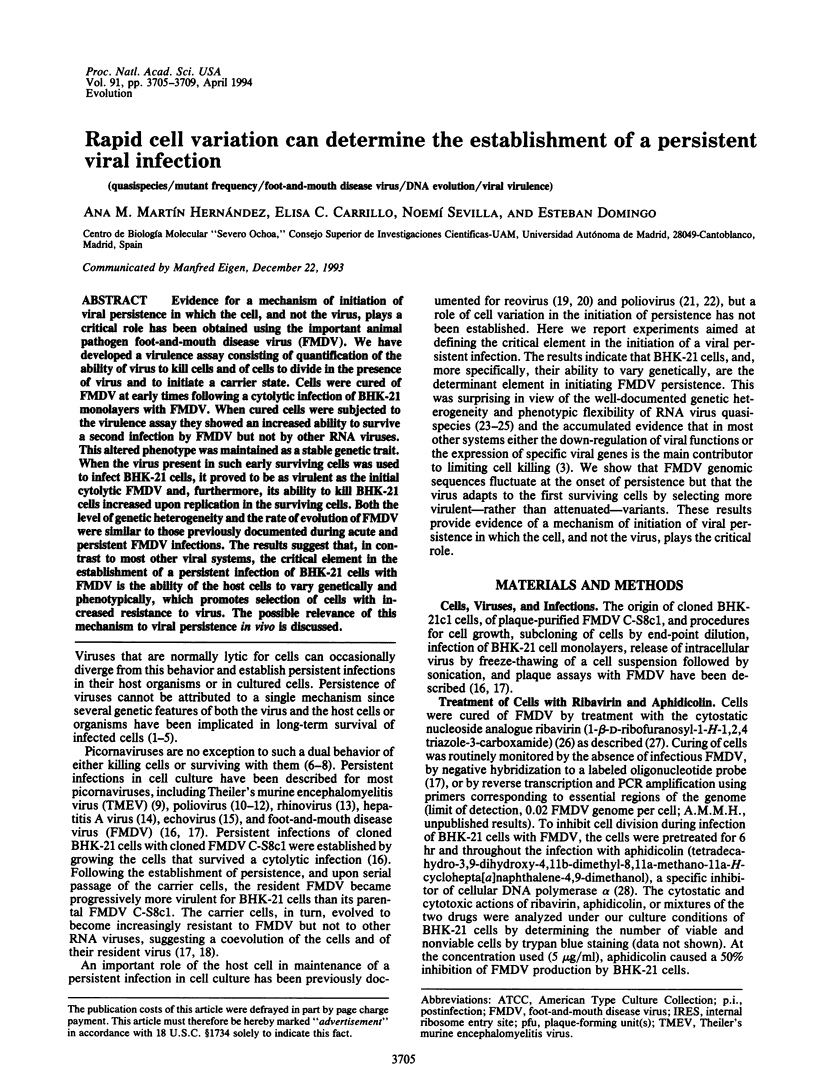
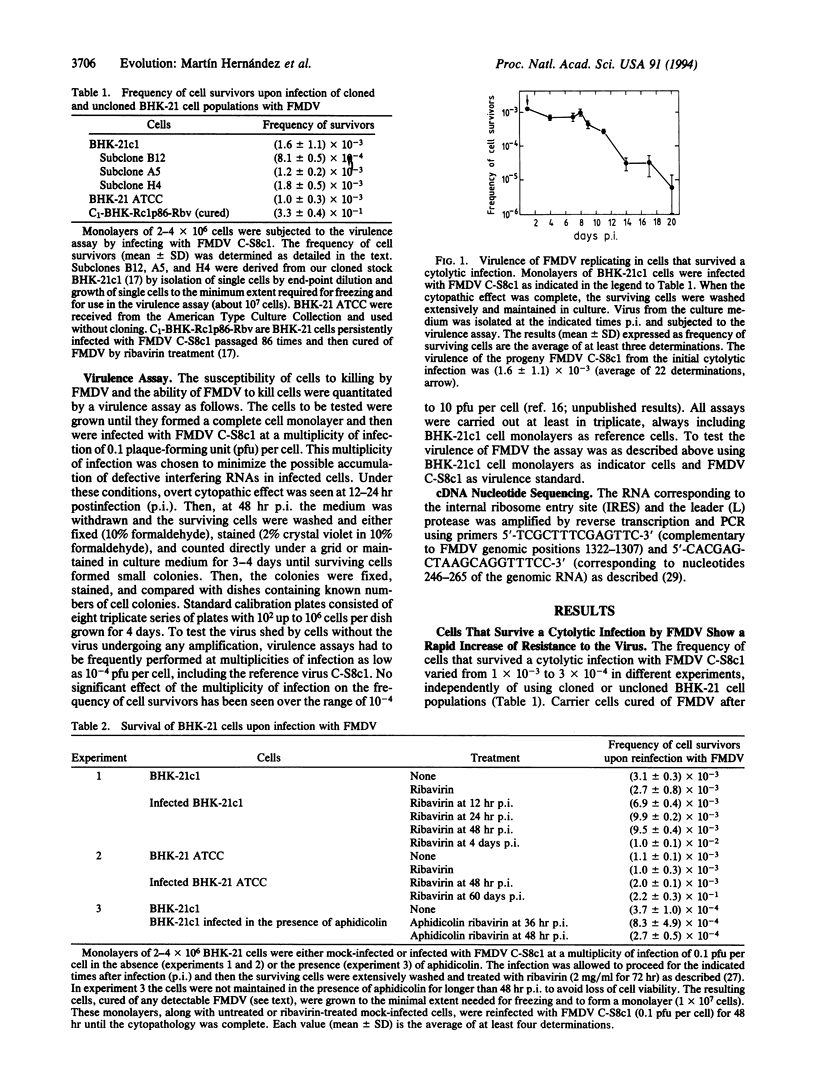
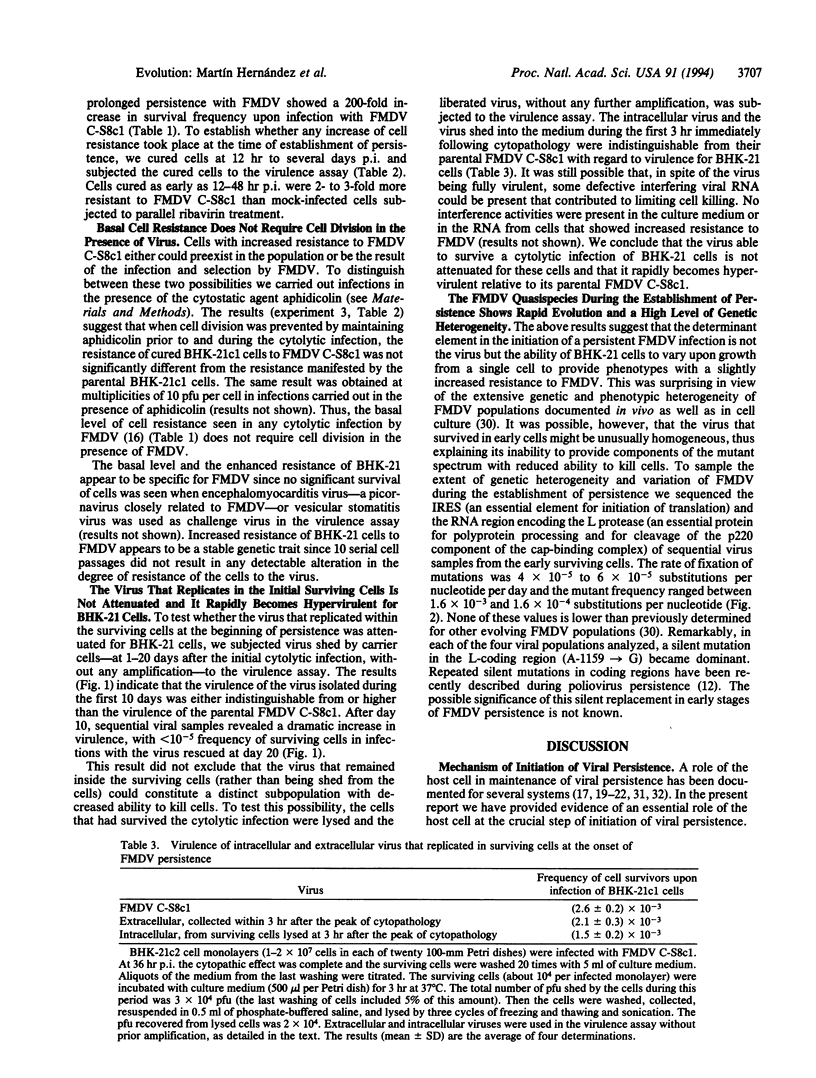
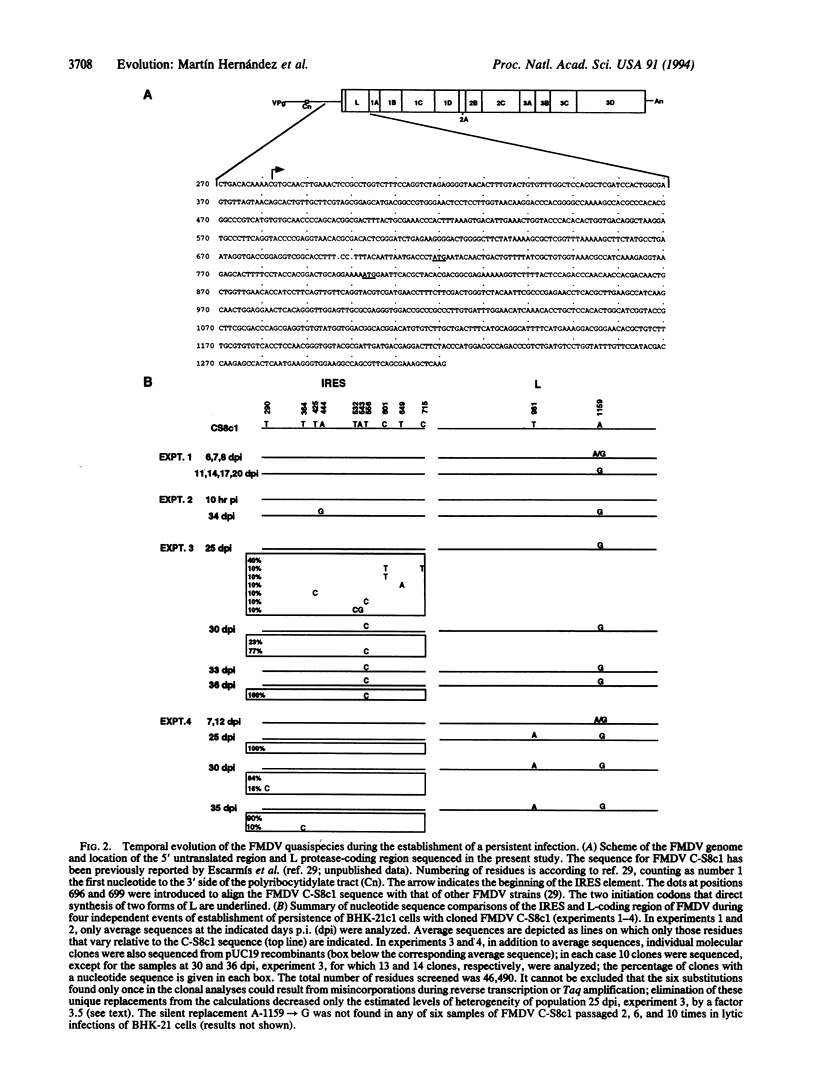
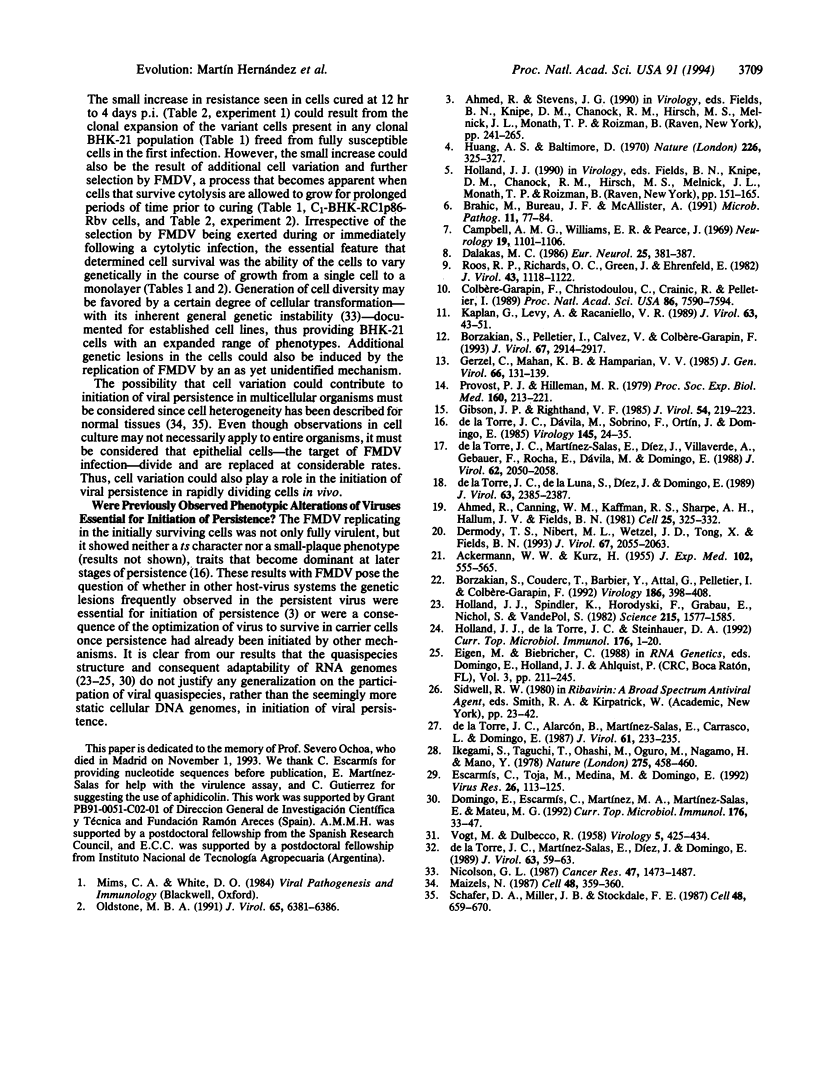
Selected References
These references are in PubMed. This may not be the complete list of references from this article.
- ACKERMANN W. W., KURTZ H. Observations concerning a persisting infection of HeLa cells with poliomyelitis virus. J Exp Med. 1955 Nov 1;102(5):555–565. doi: 10.1084/jem.102.5.555. [DOI] [PMC free article] [PubMed] [Google Scholar]
- Ahmed R., Canning W. M., Kauffman R. S., Sharpe A. H., Hallum J. V., Fields B. N. Role of the host cell in persistent viral infection: coevolution of L cells and reovoirus during persistent infection. Cell. 1981 Aug;25(2):325–332. doi: 10.1016/0092-8674(81)90050-7. [DOI] [PubMed] [Google Scholar]
- Borzakian S., Couderc T., Barbier Y., Attal G., Pelletier I., Colbère-Garapin F. Persistent poliovirus infection: establishment and maintenance involve distinct mechanisms. Virology. 1992 Feb;186(2):398–408. doi: 10.1016/0042-6822(92)90005-a. [DOI] [PubMed] [Google Scholar]
- Borzakian S., Pelletier I., Calvez V., Colbere-Garapin F. Precise missense and silent point mutations are fixed in the genomes of poliovirus mutants from persistently infected cells. J Virol. 1993 May;67(5):2914–2917. doi: 10.1128/jvi.67.5.2914-2917.1993. [DOI] [PMC free article] [PubMed] [Google Scholar]
- Brahic M., Bureau J. F., McAllister A. Genetic determinants of the demyelinating disease caused by Theiler's virus. Microb Pathog. 1991 Aug;11(2):77–84. doi: 10.1016/0882-4010(91)90001-q. [DOI] [PubMed] [Google Scholar]
- Campbell A. M., Williams E. R., Pearce J. Late motor neuron degeneration following poliomyelitis. Neurology. 1969 Nov;19(11):1101–1106. doi: 10.1212/wnl.19.11.1101. [DOI] [PubMed] [Google Scholar]
- Colbère-Garapin F., Christodoulou C., Crainic R., Pelletier I. Persistent poliovirus infection of human neuroblastoma cells. Proc Natl Acad Sci U S A. 1989 Oct;86(19):7590–7594. doi: 10.1073/pnas.86.19.7590. [DOI] [PMC free article] [PubMed] [Google Scholar]
- Dalakas M. C. New neuromuscular symptoms in patients with old poliomyelitis: a three-year follow-up study. Eur Neurol. 1986;25(5):381–387. doi: 10.1159/000116038. [DOI] [PubMed] [Google Scholar]
- Dermody T. S., Nibert M. L., Wetzel J. D., Tong X., Fields B. N. Cells and viruses with mutations affecting viral entry are selected during persistent infections of L cells with mammalian reoviruses. J Virol. 1993 Apr;67(4):2055–2063. doi: 10.1128/jvi.67.4.2055-2063.1993. [DOI] [PMC free article] [PubMed] [Google Scholar]
- Domingo E., Escarmis C., Martinez M. A., Martinez-Salas E., Mateu M. G. Foot-and-mouth disease virus populations are quasispecies. Curr Top Microbiol Immunol. 1992;176:33–47. doi: 10.1007/978-3-642-77011-1_3. [DOI] [PubMed] [Google Scholar]
- Escarmís C., Toja M., Medina M., Domingo E. Modifications of the 5' untranslated region of foot-and-mouth disease virus after prolonged persistence in cell culture. Virus Res. 1992 Nov;26(2):113–125. doi: 10.1016/0168-1702(92)90151-x. [DOI] [PubMed] [Google Scholar]
- Gercel C., Mahan K. B., Hamparian V. V. Preliminary characterization of a persistent infection of HeLa cells with human rhinovirus type 2. J Gen Virol. 1985 Jan;66(Pt 1):131–139. doi: 10.1099/0022-1317-66-1-131. [DOI] [PubMed] [Google Scholar]
- Gibson J. P., Righthand V. F. Persistence of echovirus 6 in cloned human cells. J Virol. 1985 Apr;54(1):219–223. doi: 10.1128/jvi.54.1.219-223.1985. [DOI] [PMC free article] [PubMed] [Google Scholar]
- Holland J. J., De La Torre J. C., Steinhauer D. A. RNA virus populations as quasispecies. Curr Top Microbiol Immunol. 1992;176:1–20. doi: 10.1007/978-3-642-77011-1_1. [DOI] [PubMed] [Google Scholar]
- Holland J., Spindler K., Horodyski F., Grabau E., Nichol S., VandePol S. Rapid evolution of RNA genomes. Science. 1982 Mar 26;215(4540):1577–1585. doi: 10.1126/science.7041255. [DOI] [PubMed] [Google Scholar]
- Huang A. S., Baltimore D. Defective viral particles and viral disease processes. Nature. 1970 Apr 25;226(5243):325–327. doi: 10.1038/226325a0. [DOI] [PubMed] [Google Scholar]
- Ikegami S., Taguchi T., Ohashi M., Oguro M., Nagano H., Mano Y. Aphidicolin prevents mitotic cell division by interfering with the activity of DNA polymerase-alpha. Nature. 1978 Oct 5;275(5679):458–460. doi: 10.1038/275458a0. [DOI] [PubMed] [Google Scholar]
- Kaplan G., Levy A., Racaniello V. R. Isolation and characterization of HeLa cell lines blocked at different steps in the poliovirus life cycle. J Virol. 1989 Jan;63(1):43–51. doi: 10.1128/jvi.63.1.43-51.1989. [DOI] [PMC free article] [PubMed] [Google Scholar]
- Maizels N. Diversity achieved by diverse mechanisms: gene conversion in developing B cells of the chicken. Cell. 1987 Feb 13;48(3):359–360. doi: 10.1016/0092-8674(87)90439-9. [DOI] [PMC free article] [PubMed] [Google Scholar]
- Nicolson G. L. Tumor cell instability, diversification, and progression to the metastatic phenotype: from oncogene to oncofetal expression. Cancer Res. 1987 Mar 15;47(6):1473–1487. [PubMed] [Google Scholar]
- Oldstone M. B. Molecular anatomy of viral persistence. J Virol. 1991 Dec;65(12):6381–6386. doi: 10.1128/jvi.65.12.6381-6386.1991. [DOI] [PMC free article] [PubMed] [Google Scholar]
- Provost P. J., Hilleman M. R. Propagation of human hepatitis A virus in cell culture in vitro. Proc Soc Exp Biol Med. 1979 Feb;160(2):213–221. doi: 10.3181/00379727-160-40422. [DOI] [PubMed] [Google Scholar]
- Roos R. P., Richards O. C., Green J., Ehrenfeld E. Characterization of a cell culture persistently infected with the DA strain of Theiler's murine encephalomyelitis virus. J Virol. 1982 Sep;43(3):1118–1122. doi: 10.1128/jvi.43.3.1118-1122.1982. [DOI] [PMC free article] [PubMed] [Google Scholar]
- Schafer D. A., Miller J. B., Stockdale F. E. Cell diversification within the myogenic lineage: in vitro generation of two types of myoblasts from a single myogenic progenitor cell. Cell. 1987 Feb 27;48(4):659–670. doi: 10.1016/0092-8674(87)90244-3. [DOI] [PubMed] [Google Scholar]
- VOGT M., DULBECCO R. Properties of a HeLa cell culture with increased resistance to poliomyelitis virus. Virology. 1958 Jun;5(3):425–434. doi: 10.1016/0042-6822(58)90037-0. [DOI] [PubMed] [Google Scholar]
- de la Torre J. C., Alarcón B., Martínez-Salas E., Carrasco L., Domingo E. Ribavirin cures cells of a persistent infection with foot-and-mouth disease virus in vitro. J Virol. 1987 Jan;61(1):233–235. doi: 10.1128/jvi.61.1.233-235.1987. [DOI] [PMC free article] [PubMed] [Google Scholar]
- de la Torre J. C., Dávila M., Sobrino F., Ortín J., Domingo E. Establishment of cell lines persistently infected with foot-and-mouth disease virus. Virology. 1985 Aug;145(1):24–35. doi: 10.1016/0042-6822(85)90198-9. [DOI] [PubMed] [Google Scholar]
- de la Torre J. C., Martínez-Salas E., Diez J., Villaverde A., Gebauer F., Rocha E., Dávila M., Domingo E. Coevolution of cells and viruses in a persistent infection of foot-and-mouth disease virus in cell culture. J Virol. 1988 Jun;62(6):2050–2058. doi: 10.1128/jvi.62.6.2050-2058.1988. [DOI] [PMC free article] [PubMed] [Google Scholar]
- de la Torre J. C., Martínez-Salas E., Díez J., Domingo E. Extensive cell heterogeneity during persistent infection with foot-and-mouth disease virus. J Virol. 1989 Jan;63(1):59–63. doi: 10.1128/jvi.63.1.59-63.1989. [DOI] [PMC free article] [PubMed] [Google Scholar]
- de la Torre J. C., de la Luna S., Diez J., Domingo E. Resistance to foot-and-mouth disease virus mediated by trans-acting cellular products. J Virol. 1989 May;63(5):2385–2387. doi: 10.1128/jvi.63.5.2385-2387.1989. [DOI] [PMC free article] [PubMed] [Google Scholar]


